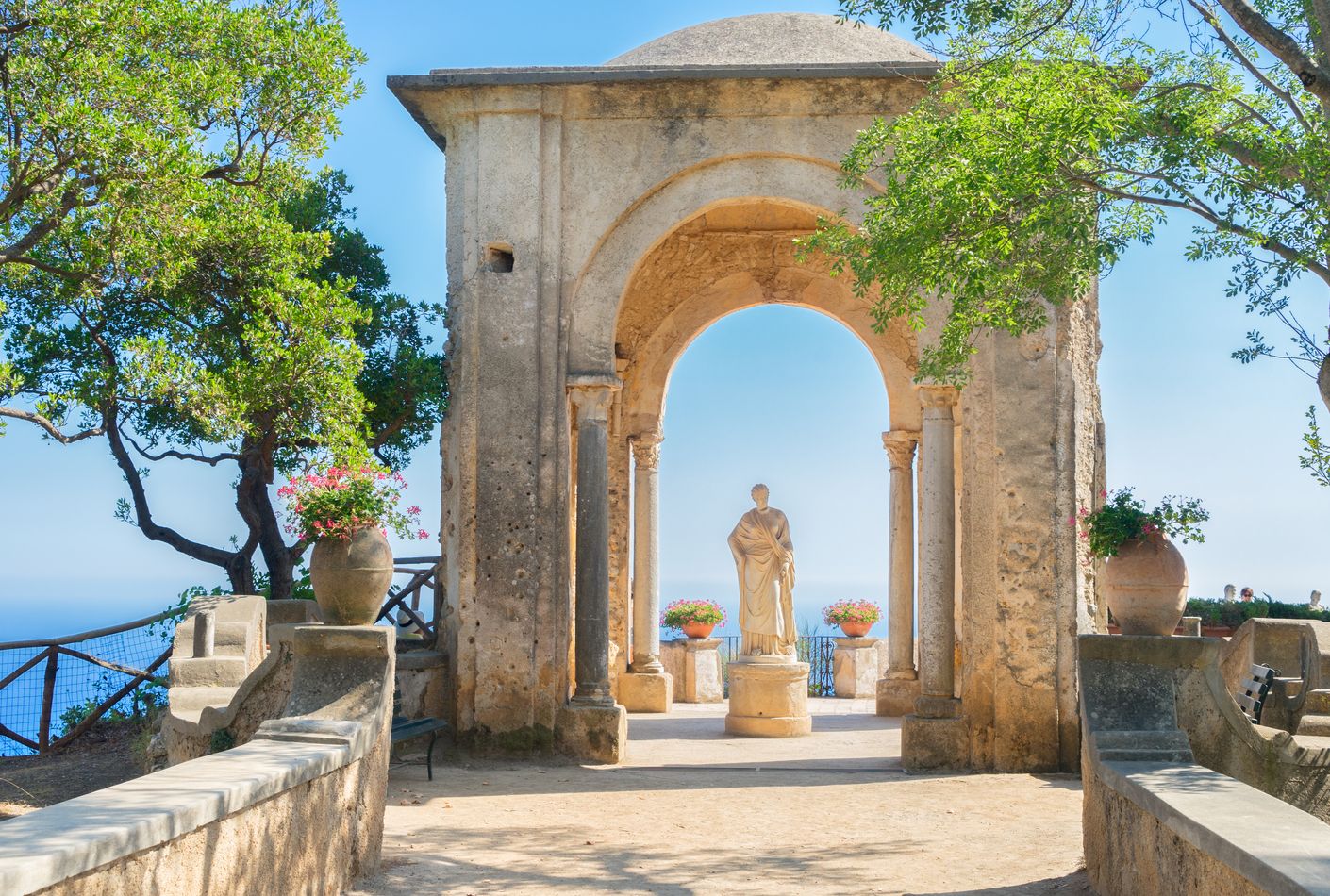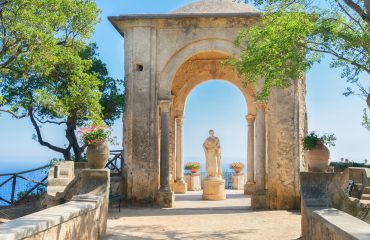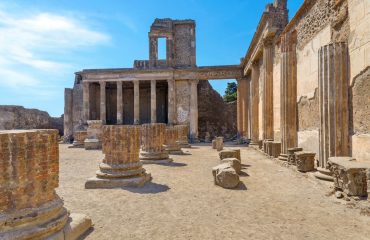LOVE AT FIRST SITE
Day trip to Pompeii & Ravello
- Reach back to the year 79 AD and see for yourself how a natural disaster of unprecedented proportions has provided a priceless key with which to unlock the past
- Thread your way through the streets and squares of Pompeii, past theatres and temples, pausing at the very earliest known Italian fast food establishment
- Feast your eyes on the breathtaking seascapes to be admired from Ravello’s gardens
-
Category
-
Hobbies & Interests
-
DurationFull day
-
Destination
LOVE AT FIRST SITE
Day trip to Pompeii & Ravello
On this full day excursion to Pompeii and Ravello you will visit one of the world’s most fascinating archaeological sites and explore the pretty streets of a charming town on the Amalfi Coast.
In the morning your private guide and chauffeur will meet you at your accommodation and drive you to Pompeii. Buried in deadly volcanic ash after the sudden eruption of Mount Vesuvius in 79 AD and accidentally discovered in 1748, Pompeii is an absolute must for first-time visitors to Italy. Your guide will take you on a carefully planned trail through this incredible ancient settlement and explain the purpose and function of the foundations and buildings you will see along the way. You will also find out about the lifestyle and customs of those who inhabited them, the techniques used to uncover and interpret findings made here and the evidence that has been pieced together to give us such a stunningly vivid and accurate picture of Roman Campania. Although much excavation work remains to be done and conservation presents the curators with a massive challenge, what you can still see and touch here is simply astounding.
Step back in time as you access the excavations through the city gate of Porta Marina. Once inside, follow your guide through the ruins of the ancient city and conjure up scenes of Pompeii’s inhabitants while they go about their daily chores. Can you imagine how life must have been in this once thriving agricultural and trading centre peacefully perched in the shadow of mighty Mount Vesuvius, unaware of the imminent disaster, 2,000 years ago? How did Pompeii’s 15,000 residents spend their time? What were their occupations, beliefs and traditions? What did they eat? Which leisure activities did they enjoy? The answers to these and many more questions are securely safeguarded within Pompeii’s crumbling walls, jigsaw pieces in a tantalizing, real life puzzle just waiting to be reassembled – with a little help from your guide.
When you stroll along the well-planned streets, taking the very same route once trodden by faithful temple-goers and busy market traders, you’ll notice the road building skills that were needed to set the large paving blocks in place and the high kerbs and stepping stones conveniently arranged to allow people to cross without getting their feet wet and dirty. This is just one small but significant example of the ingenuity of the ancient Romans in the fields of engineering and urban planning, achievements which remained unequalled for centuries and whose remarkable legacy continues to guide us to this day. Our culinary habits, pastimes and vices too may well have their roots here. From fast foods to spas, from red light districts to gambling, the ancient Romans of Pompeii were already seasoned experts in the pleasures and transgressions of the city.
Your guide will certainly point out Pompeii’s age-old venues for public meetings: the forum, once the site of the market, administrative offices and court; the thermal baths where citizens came to relax, play sports and socialise; the temples, a source of precious clues to our understanding of the creed and religious rituals of yesteryear’s worshippers. Theatres were popular with the locals who gathered here to watch a varied calendar of shows, such as Greek tragedies, musical performances, poetry readings and the much-loved light-hearted plays that featured frauds, betrayals and brawls. You will also take a peek inside a private residential villa which provides a wonderful example of the layout of a wealthy citizen’s dwelling and the decorative tastes of the age.
Casts of the bodies of the ill-fated population, trapped forever at the very moment of death, leave the visitor with a particularly haunting memory of a cataclysmic event that has meticulously secured for us so much priceless knowledge about the Roman way of life.
After some free time for lunch rejoin your guide and driver and set off for one of the Amalfi Coast’s best-loved summer resorts.
Clinging to the hillside, 335 metres above the sparkling Tyrrhenian Sea, the pocket-size town of Ravello has captivated countless artists, writers and musicians throughout the centuries with its beguiling location, unparalleled panoramas and splendid gardens. Founded in the 5th century as a refuge from the Barbarian invasions, Ravello flourished under the rule of Amalfi when wealthy merchants built its most famous villas. The lovely town centre made up of a picturesque central piazza and a maze of narrow streets, lined with cosy cafes, elegant restaurants and ceramic shops, offers much to explore and discover. Notable buildings include the 11th century Cathedral of San Pantaleone, famous for its two splendid pulpits, bronze doors and the relic of Saint Pantaleone’s blood, and the Church of San Giovanni del Toro, home to the pulpit mosaics that prompted M.C. Escher to create his interlocking patterns.
But above all, the spectacular vistas to be admired from Ravello’s two famous villas will make you fall head over heels in love with the town. Villa Rufolo, whose dreamlike setting inspired the enchanted Garden of Klingsor of Wagner’s Parsifal, is situated just off the main piazza. It was built in the 13th century although we owe its present appearance to Sir Francis Neville Reid, a botanist from Scotland, who renovated the villa and brought the gardens back to life in the 1800s, after a period of decline. The highlight of the garden is a large rectangular area with carefully manicured flowerbeds of radiant colours which serves as a balcony from which to look out on glorious views of the coast. Here, against a magnificent backdrop of sky and sea, open air chamber concerts are held annually from spring to autumn.
Located on the cliff edge, the 11th century Villa Cimbrone is one of the most exquisite spots on the Amalfi Coast. The villa was revamped in the early 1900s and today hosts a luxury hotel which is not open for public tours. Visitors may enjoy a serene stroll under the wisteria pergola and through the garden, punctuated with statues of classical figures and fine architectural elements. The star attraction of Villa Cimbrone is the belvedere poetically named Terrace of Infinity. Beyond the marble busts that decorate the railing you can admire heady views of the vivid blue sea and jagged coastline below. Described by Gore Vidal as “the most beautiful place that I had ever seen in all my travels”, the terrace is sure to make your heart miss a beat.
After the tour your private chauffeur will drive you back to your accommodation.
- A Mercedes vehicle and professional driver at your disposal for a full-day excursion to Pompeii and Ravello
- A full-day private tour of Pompeii and Ravello with an expert licensed guide
- Entrance tickets to the archaeological excavations in Pompeii
- Entrance tickets to the gardens of Villa Rufolo and Villa Cimbrone in Ravello
- Tips
- Meals
- The order of the sites visited may change
- This excursion can be arranged as a day trip from Sorrento, Positano, Amalfi and Naples






